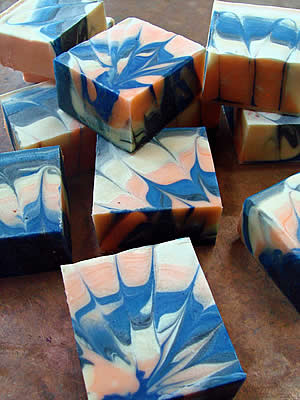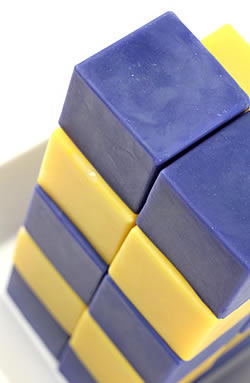The following article on soap coloring options was inspired by a reader’s question concerning the differences between oxides, micas, ultramarines and colorants and when to use which one.
Soap Coloring Options: Oxides, Micas, Ultramarines – What’s the Difference?
by Anne-Marie Faiola
You’re right, there are a lot of soap coloring options out there. I’ll go over the most common and the pros and cons:
(1) Pigments
Oxides and ultramarines fall into this category. Pigments, like most colorants out there, do not fall into the natural category. But take heart, they are “nature identical.”
Pigments are manufactured in labs and have been since the 70’s. Apparently, pigments (oxides and ultramarines) used to be mined but the FDA stepped in and demanded some purity, so since then, these colorants have been manufactured in a lab – same molecular structure just a different way of processing.
Some Iron Oxides are still extracted naturally; however, Iron oxides in nature (dirt) are often stuck with toxic metals like lead, arsenic, mercury, antimony and selenium (when they are in nature). This is why the FDA stepped in to regulate cosmetic colorants so the level of toxic metal present are present in such low concentrations that they are considered “safe.” In fact, only synthetically prepared iron oxides are approved for use in cosmetics in this country. (Johnson, S.T. & Wordell, C.J. “Homeopathic and herbal medicine: Considerations for formulary evaluation,” Formulary, 32, 1167, Nov. 1997. )
The good things about using pigments in soap is that they are stable. Generally, they will not morph or change colors in Cold Process or Melt and Pour soap. They are also cost effective; at $3-$6 per ounce, you’re looking at a very cheap, per pound price, for color. The drawback to using pigments is that they tend to clump and so they require extra TLC to get them not clump.
Tip: Use a latte frother (or mini-mixer) to help pre-mix your pigments in a bit of liquid oil before adding to your soap. This will help disperse and break up any clumps.
(2) FD&C Colorants
There are many types of FD&C colorants, but basically they are manufactured in a lab, are not natural but are generally incredibly easy to use and give a wide (anything you imagine) range of color. There is wide spread distrust, and even fear, about FD&C colorants. This is most likely because the FDA has recalled colors in the past because of safety concerns. The most well known example is probably Red No. 2, banned in 1976 over possible links to cancer. In truth, FD&C colorants are in most, if not all, processed foods we eat (from cheese to french fries to candy) and fears about the use of these colorants in soap, while well meaning, are probably unfounded. In addition, the miniscule amount of this type of colorant in soap (which doesn’t stay on your skin), is the least of concerns compared to the rampant amount of FD&C colorant in food (and vitamins etc…).
The nice part of using FD&C colorants is that they are, on a per use basis, fairly inexpensive to use. They are incredibly concentrated. They also mix in smoothly. They normally stay clear in MP. The bummer part is that they are not stable, at all, in alkaline environments (aka – cold process soap). It’s the rare FD&C that actually stays stable. They normally stay clear in MP. However, they will bleed. For more information, click here to read about bleeding colorants at the Soap Queen Blog.
(3) Micas
These should fall into the FD&C colorants category because mica is a natural product, that is mined but then, the individual mica (which looks like a platelet) is coated with FD&C colorants, or pigments, or a combination of both to achieve the colorant. The dual sided color is what causes the shimmer and sheen of micas. Mica is exactly the same stuff you see in your lipstick, eye shadow and blush. Micas work best in clear products, like clear melt and pour, because the shimmer needs light in order to reflect and refract nicely.
The great part about using micas in CP is that they don’t clump at all. The colors are so smooth and wonderful to work with. The bummer part about using micas in CP is that they have a higher usage rate than both pigments and straight FD&C colorants. They also do provide just a tinge of sheen in CP, and that looks sophisticated. Another bad thing about micas in CP, is that, since they are coated in FD&C, some of them are not stable in CP soap and do require testing.
(4) Natural soap colorants
There is no legal definition for a natural color. FDA classifies colorants as those requiring certification and those not requiring certification. “Exempt colorants are inherently neither more nor less safe than certified colorants,” concludes an article in the Encyclopedia of Chemical Technology. We may consider them as less hazardous because we perceive them as “natural.” But “like all color additives, they are fabricated products.” Historically, bugs were ground up for colorant. Today, potential customers get squeamish about that so we skip that. Cochineal (the legs of a some bug, if I remember correctly) was a favorite for a nice red color. Some popular ones to use are:
Yellow – Annatto, Saffron, Turmeric, Carthamin
Green – Chlorophyll
Brown – the Cocoa Bean (pods, shells, stems), Cocoa Powder, Fermented Tea
Red – Paprika (may be irritating)
Purple – Alkanet Root (for CP)
And the list goes on…
The nice part about using natural colorants is the marketing angle; the general public believes that natural is better so you can market this well. However, it is difficult to achieve the color you want, using natural colorants, and sometimes, you can’t get a smooth color (depending on the herb used). Another problem is that some of the colorants are expensive to use.
The bummer part about pigments is that they tend to clump and so they require much extra TLC to get them not to clump. Here is a tutorial about using oxides in melt and pour soap at the Soap Queen Blog.


